So you’re gathering some ideas for review games, here at the end of the unit or the school year? There are so many fun and popular games to choose from! But are they all comprehensible and engaging for your English learners?
A little personal testimony. I love test review. It’s such a fun time of year for me. As a class, you get to look back at all you’ve learned throughout the school year. Some memories pop up of fun activities you did, things that made you laugh, or super successful projects that everyone will remember years from now. It’s a chance for a little competition, a little physical activity perhaps, and hopefully a lotta content review. Test prep can be intense, exhausting, and potentially a ton of fun.
However, many a year have I introduced an amazing review game, just to find that while some students are super engaged and loving it, some of my English learners…not so much. Some students are able to fully comprehend the game, recall the needed information, and communicate well enough to compete. While others end up quiet, anxious, or disengaged.
As a teacher, I remember feeling a little stuck when it came to finding ideas for review games. I wanted to come up with something fun for my students, but a lot of the ideas out there (I realized after the fact) didn’t invite my ELLs into the review process very well.
But never fear! I’ve got some tips today that will help you sift through the sea of ideas for review games, and choose some that will benefit all your learners!
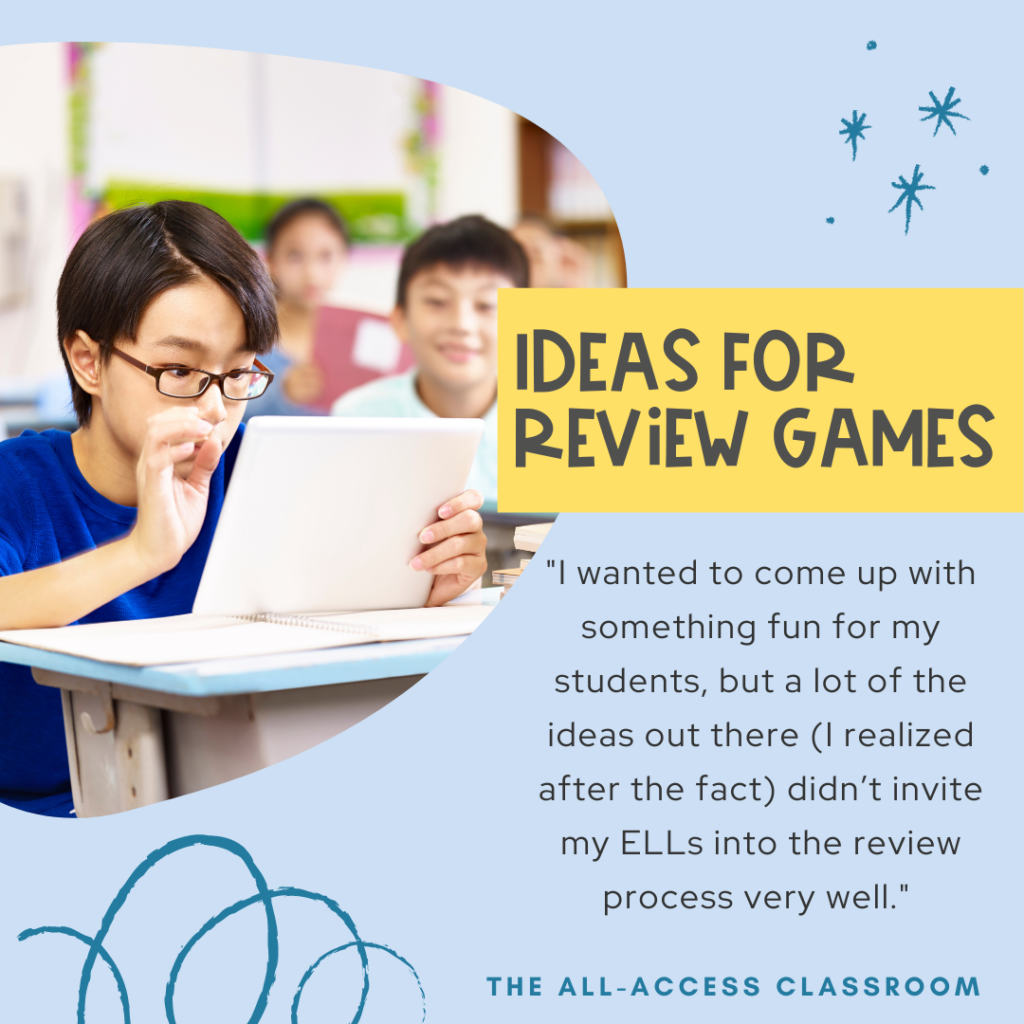
Consider ELs when Planning Activities and Review Games for Tests
Ok, so before you go Googling or perusing Teachers Pay Teachers for review games for tests, I just want to offer some things for you to keep in mind.
Particularly for your newcomers and ELs at emerging proficiency levels, there are some things they need in order to fully participate and benefit. You want to present activities that:
Aren’t too faced-paced
You know how games can get. Kids yelling multiple words at lightning speed? Your ELs may have difficulty understanding what’s being said. Got a game that favors the team/individual that answers first? That lack of wait time or thinking time may discourage your ELs, who need a hot minute to process.
Include visuals
I can’t stress this enough. In my experience, review can potentially involve kids reading a LOT of text. For your ELs, can you imagine the cognitive load of suddenly having to recall all the content knowledge and vocabulary, and to have text-only resources conveying all this info? Adding visuals wherever possible will be a tremendous support. It will increase comprehension, and help students’ brains synthesize the heavy content.
Create a Context
It’s easy to approach review week with a somewhat haphazard approach. A little o’ this, a little ‘o that…. If you treat review like eating trail mix, your students won’t have a context in which to place your reviewed content, and their brains will be having to jump all over the place. They’ll hear and read a lot, but they may not be making meaningful connections that help the info stick. Instead, map out an order for review that makes sense. Chronologically, by unit, or just (at minimum) keeping all related info/skills together.
Allow for collaborative work/partner work/opportunities for discourse
Talk about reducing anxiety levels! Choosing ideas for review games that allow your ELs the support of peers (rather than the potential judgement, ridicule, or pressure of peers) will make a huge difference! Plus collaborative work will give all students a comfortable space to share what they know, question, and challenge each other in a non-competitive way. And we always love it when we get kids talking!
Don’t put kids on the spot
I think we’ve all had those experiences as a kid playing a game. Everyone looking at you, time running out, a bazillion thoughts racing through your mind as you try not to let your team down. This experience can be so scary for ELs, and the last thing you want them to do is shut down. I always avoid any games that will potentially put kids in this situation (Around the World, Hot Seat, etc.), and look for ways to get partners or teams competing together.
Make Thinking Visible
This is a HUGE one! Expanding information beyond plain text and getting it out into visual form will benefit all your learners! Think: graphic organizers, charts, student drawings, sketch noting, artistic projects, posters, creative presentations, resurfacing past anchor charts or word walls… So many possibilities.
Incorporate academic language and cognitive process verbs that may appear on the test
Hopefully you’re aiming to teach such terms throughout the school year, but test review is a great time to explicitly review them. All your students will benefit from digging into the meanings, use, and examples of terms such as “compare,” “characteristics,” and “represent.”
The bottom line is….all the scaffolds and supports you’ve used with your ELs this year…should also be present in your review games for tests. Makes sense, doesn’t it?
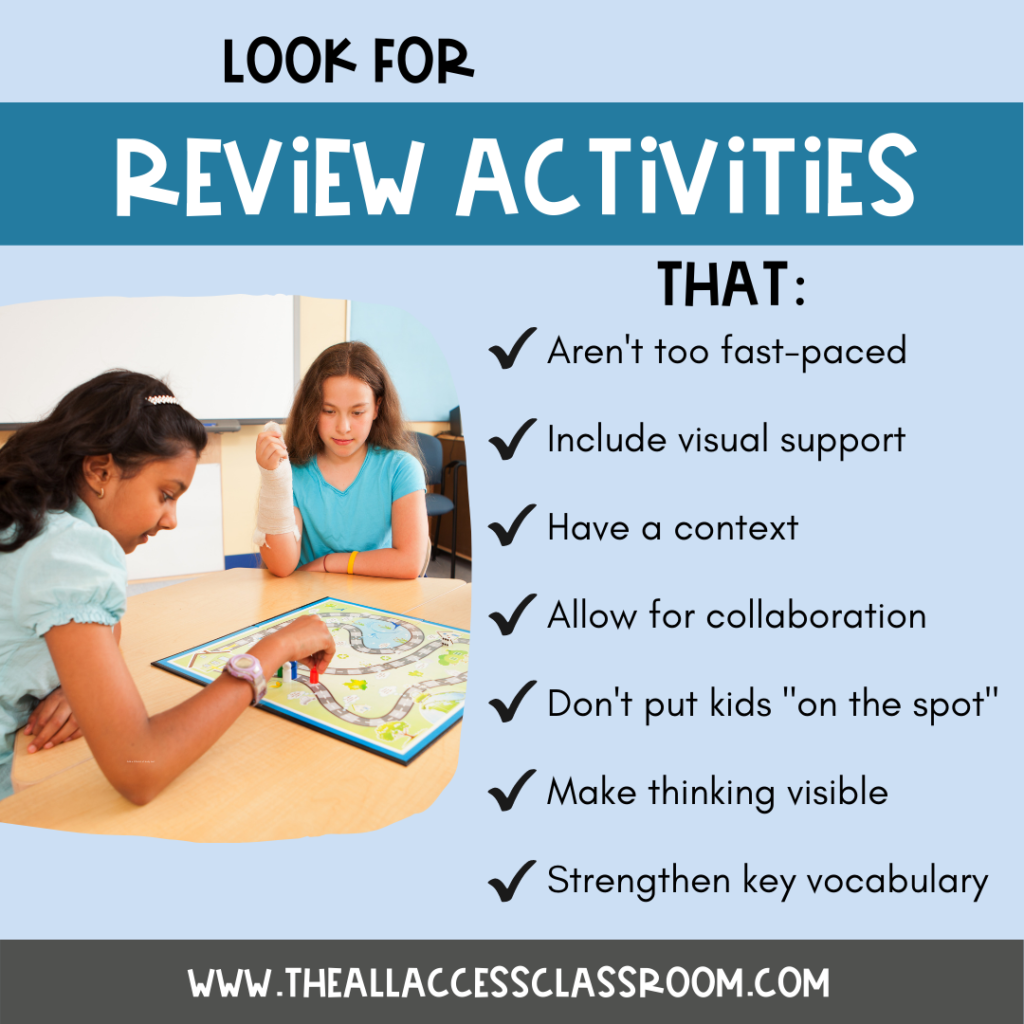
7 Activities and Review Games for the Classroom
Need some ideas for EL-friendly activities and review games for the classroom? Here are some of my faves. They’re not all “perfect” in meeting the criteria above, but they’re definitely a step up from doing reading passages all day! 🙂
1. Gallery Walk
I use this as a way to assess and build background knowledge at the beginning of a lesson. But one variation is great for review, too! Whether using poster paper placed around the room, or the digital version, you’ll put kids in groups. On each “picture frame” of the Gallery Walk, you’ll place a review question. As teams rotate to each frame, they’ll discuss and solve/answer, then write their thinking/solutions on sticky notes (kept with their group). Once all groups have visited all frames, you might allow each group to share out about one designated question, sharing their problem solving process. Expand by inviting other teams to join in a discussion about each problem.
Check out my digital Gallery Walk here!
2. Graffiti Review Game
This is a super way for ELs to feel autonomy while having peer support available. Students have their own personal workspace on large paper, where they answer questions with the support of their partner. They can draw or write to work their way through a given problem, question, or prompt. Check out Jennifer Findley’s directions for this game here.
3. Comic Strip
This can be a fun way to review Social Studies or ELA concepts with students, while minimizing the amount of written output. You’ll need a blank comic strip template for students. After reviewing a given concept, ask students to represent it through a sequence of events or conversation involving two characters. You’ll need to give parameters such as: which terms they should include, length, the purpose/goals of the comic strip, etc. I like to prevent the “have to have it perfect and detailed” challenge by requiring that the characters be stick people. 🙂 You can check out this online comic strip creator, and a planning sheet here.
4. Reviewing vocabulary
As you move through each section of review, you may wish to highlight some key vocabulary through a graphic organizer/template. (Adding gifs to these is so fun!) I like this resource from Ashleigh’s Education Journey as well. It’s a booklet that lets students spend some time with the language that may be seen on the test directions/questions. This BINGO game is another fun way you could review the academic vocabulary (particularly verbs) that students may see on the test. (Scroll a bit down the linked page for directions.) Just make sure to present examples/prompts that are supported by visuals, wait time, etc.
5. Reverse charades
My 6th grade teacher husband loves this one. Typically in charades, one person acts out a term silently to a group or the class. This version takes away the pressure/embarrassment factor for ELs. Here, the whole class acts out the term for 2-3 “guessers,” who can cooperate to make a guess. Instant lowered affective filter, yay! For increased support, you might give the guessers a list of the terms being “drawn from” for the acting out. Here’s a video to explain further. You’ll tailor this game to fit your needs and your class, of course.
6. Brain Dump
Get it all out! (Basically the directions for this one.) 🙂 You’ll give the students a specific topic or unit of study that involved a lot of learned information/facts. You’ll present a format for them to share their thoughts. The best formats will allow students to present ideas via a variety of modalities (i.e. drawings, recorded audio, text, video, etc.) Apart from good old poster paper, you could also use Padlet, Jamboard, or Flipgrid for this activity. Challenge students to see which individuals/team can come up with the most unique ideas, giving points if you wish. Check out this blog on teaching students the Brain Dump strategy.
7. Differentiated Task Cards
Tasks cards that provide text at different levels of complexity can be a quick way to get some practice in, while keeping things accessible for ELs. Check out these, for math review. Tip: For additional support, you might pull from the cards some key terms that students will need to understand to complete the activities. You can create a quick reference sheet including these terms, definitions, and visuals, for the students to have on-hand as they go.
Tip:
If you do want to use an activity with primarily on-grade level text that not all students can access independently, make sure ELs have a buddy who can support them. Then make sure you go over each piece of text as a class. I love to mark the text up with arrows, underlines, circles, drawings, annotations…whatever will help the ELs understand your thought process better and help them decompose the relevant elements of the text.
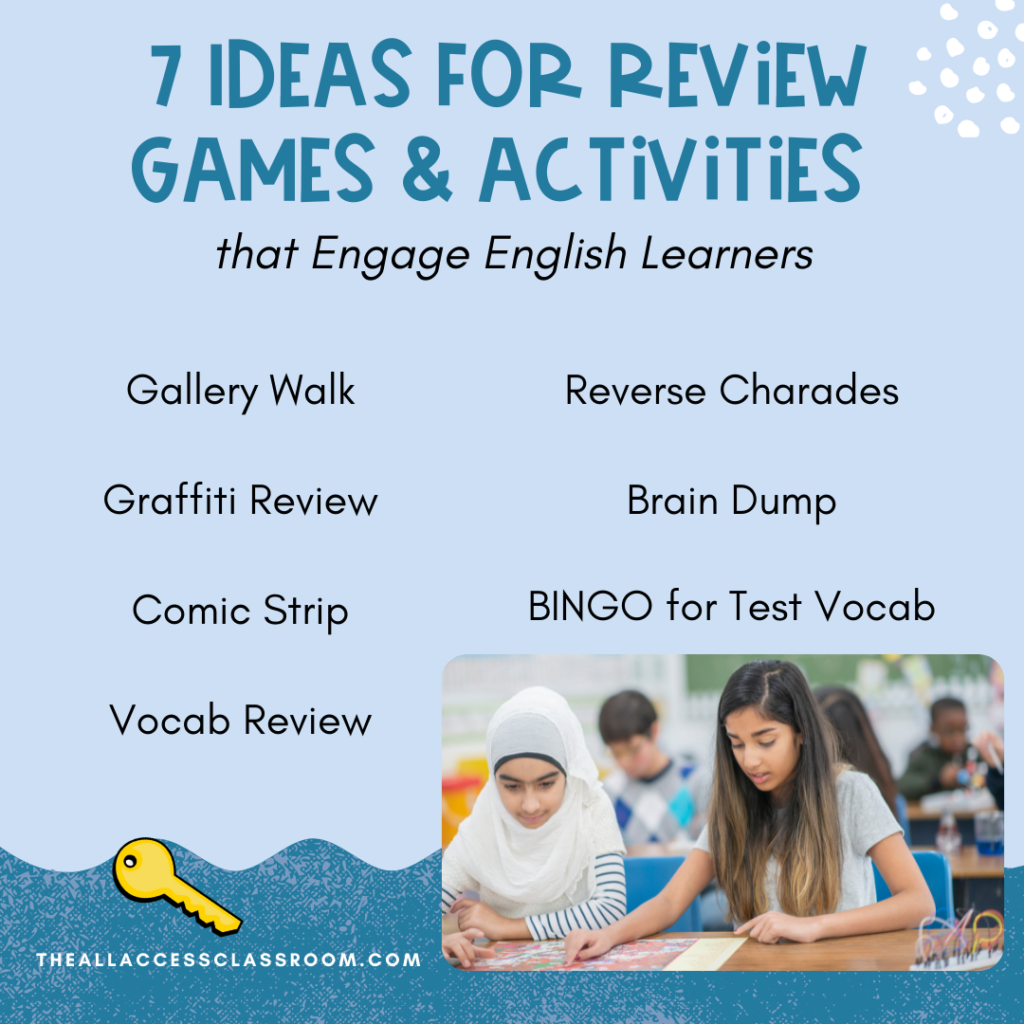
Questions to Ask Before Introducing a New Review Activity to Your Class
So as you dive into all those amazing ideas of review games floating around, make sure you vet each one by asking:
- Will it create a low-anxiety context in which my ELs can enjoy themselves?
- Does it encourage student engagement and discourse?
- Does it offer some kind of visual support?
- Is it presented as part of a broader context/order?
- Will my ELs have the opportunity to be successful in this activity, without having to fully rely on their partner/group the entire time?
- How might I highlight the directions and vocabulary of this activity, to ensure that my ELs are prepared for it?
More Ideas for Review Games and End of Year Test Prep Resources
There are so many places to look when you need end of year test review ideas. A couple other great places to look:
Upper Elementary Snapshots: 6 Review Games for the Classroom
We are Teachers:12 Super Creative Curriculum Review Games and Ideas
You might also want to check out:
Use a Frayer Model template for vocabulary review
Free template for quick and easy Content and Language Lesson Objectives
I know your students will LOVE diving into some test review with you! Let me know if you use one of these ideas for review games, and how it goes! And as always, email me at courtney@theallaccessclassroom.com if you have any questions!


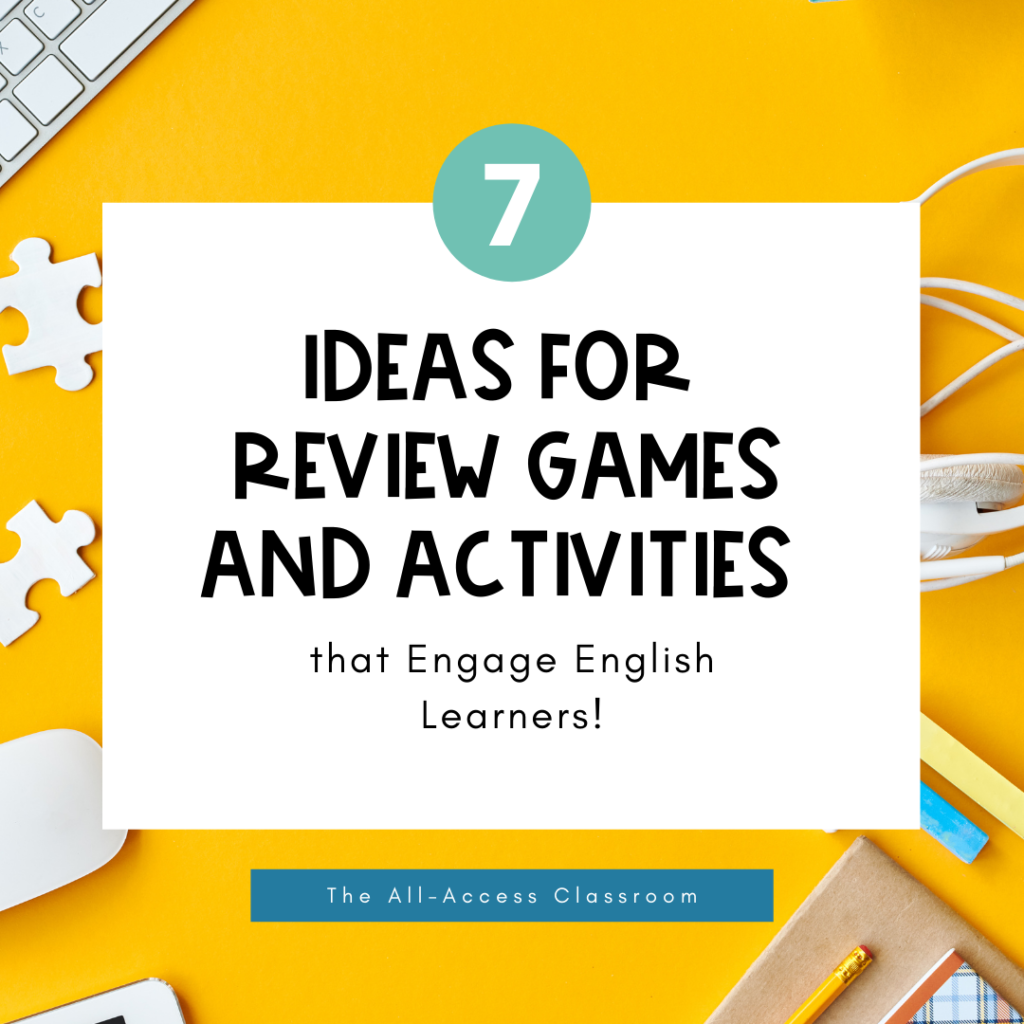
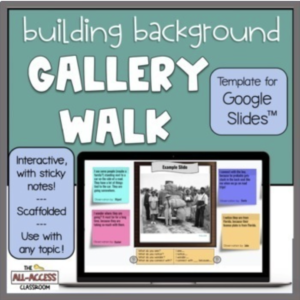

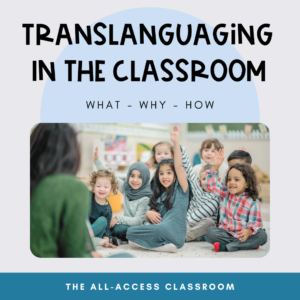


One Response